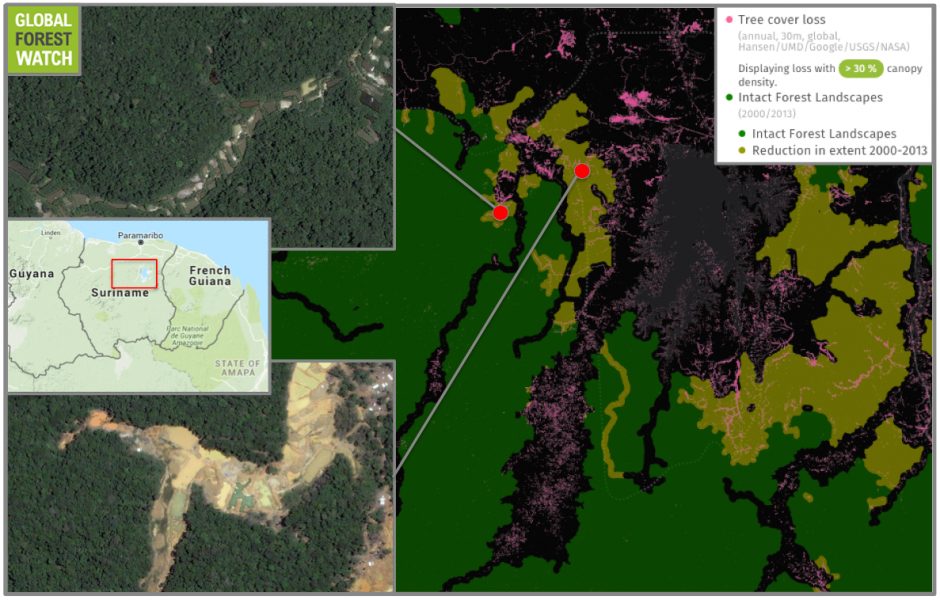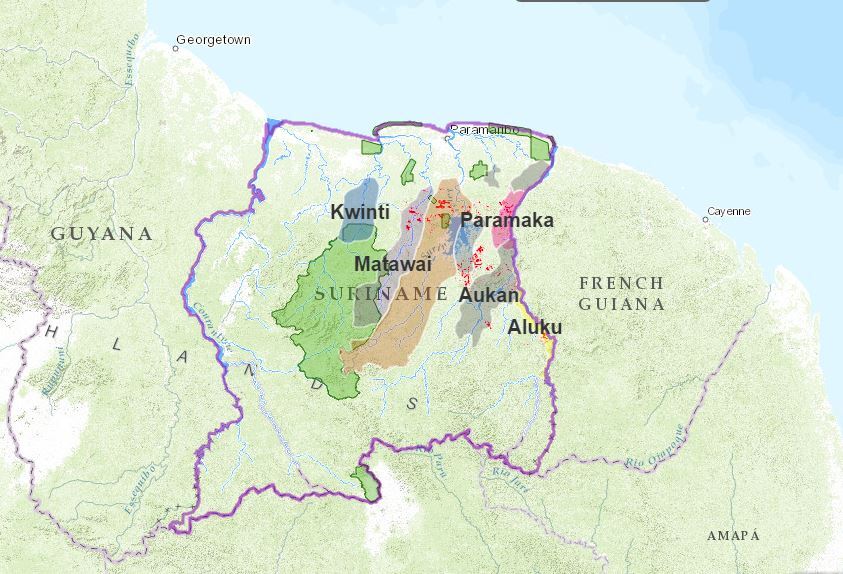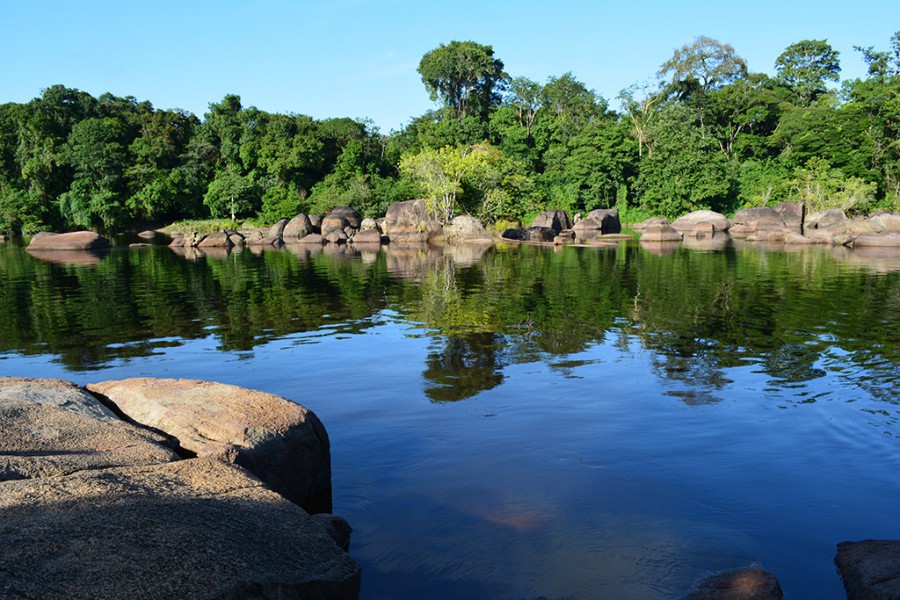By Apoorva Joshi / Mongabay
This is the second in a two-part series on gold mining in Suriname. Read the first part.
- Gold mining in the small South American country grew by 893 percent between 2000 and 2014.
- Much of the small-scale and industrial gold mining in Suriname is taking place within the boundaries of the traditional territories of local communities.
- With gold prices continuing to rise overall despite recent drops and Suriname’s political economy deeply entrenched in resource extraction, conservationists worry mining expansion will be hard to stop.
High gold prices combined with lax land use regulations have led to an explosion in mining in Suriname. A recent report by the Amazon Conservation Team (ACT) finds that gold mining in the small South American country grew by 893 percent between 2000 and 2014, and is threatening the health and ways of life of many communities in the region.
Much of the small-scale and industrial gold mining in Suriname is taking place within the boundaries of the traditional territories of the Maroons – descendants of formerly enslaved people of African heritage who escaped from plantations during Dutch colonial rule and established thriving communities in the country’s hinterlands after successfully fighting for their freedom.
Suriname’s six main Maroon communities all reside along rivers leading upstream deep into the rainforest, the report says. The majority of Maroons live in the central-eastern part of the country – where the mineral-rich Greenstone Belt and gold deposits are located. Through statistical analysis, the ACT discovered that encroachment of gold mining is significantly more severe within Maroon territories than outside of them. The team writes that only one Maroon community far from the Greenstone Belt is currently not seeing any gold mining on their lands.

Suriname boasts large tracts of intact forest landscapes (IFLs), which are continuous, undisturbed areas of primary forest. However, Global Forest Watch shows significant IFL degradation, with the country experiencing nearly 17,000 hectares of tree cover loss in its IFLs between 2001 and 2014. Much of this is happening in areas with gold mining activity.

Mining extent (red) in Maroon-occupied areas. Image courtesy of the ACT.
For some Maroon groups, small-scale gold mining has become a major component of their landscape and their daily lives. In many of their villages – particularly in Paramaka, Aukan and Matawai communities – villagers have become economically dependent on gold mining. Anthropologist Marieke Heemskerk has shown that in some Maroon villages, 70 to 80 percent of households get their regular income from family members working in gold mines. Villagers with informal concessions are able to collect fees from the garimpeiros – the Brazilian miners – and others working on their lands, and some have become quite wealthy as a result.
The Matawai Maroons who live along the Saramacca River in central Suriname, are among the smallest of the Maroon communities in terms of population. Their territory covers about 560,000 hectares and many of their villages are among the most remote and least-known in the country. Consequently, the Saramacca River, the surrounding ecosystem and the villages themselves remained relatively quiet and peaceful while other Maroon communities were contending with the pressures of inland colonization and resource extraction.
The northern portion of the Matawai territory, however, is located in the reaches of the Greenstone Belt. Being close to populated settlements, they are easily accessible via roads. This has allowed rapid expansion, with a number of the northern Matawai villages located at ground-zero for Suriname gold mining.
“According to our calculations derived from deforestation data, 81.51% of all deforestation in the Matawai territory is due to gold mining,” the report says.
Community members from the Matawai villages of Boslanti and Vertrouw learning to use GPS technology in a village mapping exercise. Photo courtesy of the ACT.Community members from the Matawai villages of Boslanti and Vertrouw learning to use GPS technology in a village mapping exercise. Photo courtesy of the ACT.
Four Matawai villages – Nyun Jakobkondre, Balen, Misalibi, and Bilawatra have been particularly impacted by the large gold mines that encircle them. In fact, much of the small-scale mining in the region is done by Maroons themselves, which is threatening their traditional livelihoods of hunting, fishing, woodworking, etc.
“As more Maroons in the Matawai community and elsewhere are becoming dependent on partaking in mining for household income, these and other local practices are eroding,” said Rudo Kemper, GIS and Web Development Coordinator for the ACT. “Many of the Matawai youth in particular are no longer as interested in traditional activities, as they know that there are lucrative profits to be made working in the mines.”
To make matters worse, mining activities has polluted waterways with mercury, which is used to separate the gold ore from sediment. Mercury can act as a neurotoxin, and has contaminated river fish, which are no longer safe to eat. Arable land is also threatened. According to Kemper, “in areas like Nyun Jakobkondre, the gold mining is taking place so close to the village that fertile land for cultivation is becoming scarcer.”
Nieuw Koffiekamp, a village settled by Maroons after it was relocated because of floods, is now located right in the middle of one of the most prosperous and mineral-rich veins of the Greenstone Belt. Known as Gros Rosebel, the area was one of the first industrial mining concessions in Suriname. Villagers have been using the area for sustainable livelihoods for generations, but the ACT report alleges they were neither consulted with nor informed about the concession. Years later, the government set up a task force dedicated to relocating the village once more. The village continues to fight for its existence, despite being literally fenced in by gold mining activity. Community members argue they have the right to extract resources from their own land and thus participate in small-scale gold mining.
Even Brownsberg Nature Park, a 14,000-hectare reserve and popular tourist destination, hasn’t been spared from the clutches of mining. From early on, gold miners have been active within its boundaries, where an estimated 924 hectares of primary forest has been lost to gold mining. In 2012, deforestation in the park reached an all-time high, with 200 hectares of forest cleared. In that same year, public awareness about mining inside Brownsberg began increasing when WWF–Guianas published a report with aerial photography of the damage to the park. “Since then,” Kemper said, “the rates of small-scale mining in the boundaries of the park have dropped somewhat, although deforestation caused by mining in the park [continues] to expand.”
Partially republished with permission of Mongabay. Read the full article, Gold mining boom threatens communities in Suriname
